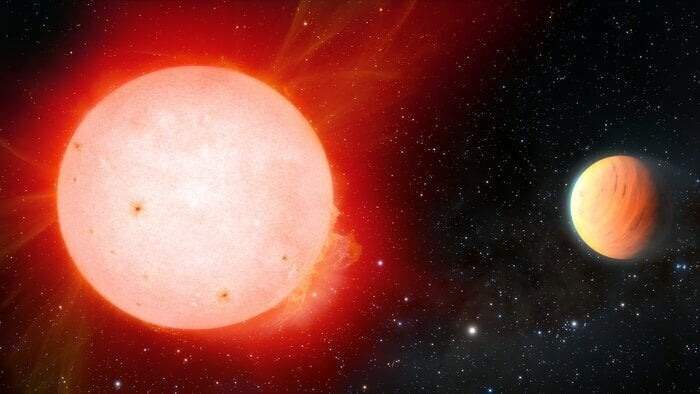
Astronomers are finding all sorts of weird worlds.
Some likely rain gems from metallic clouds. Others may be completely covered in sprawling oceans. And scientists now have a new addition to the planets beyond our solar system, called exoplanets: Meet the “fluffy” world TOI-3757 b. Astronomers think it has an atmospheric density similar to a marshmallow.
Weird? Absolutely. But our planet is deeply strange, too. There’s no reason to think the universe — a place teeming with hundreds of billions of galaxies that each contain billions of stars and an untold number of planets — wouldn’t be, well, otherworldly.
Atop a mountain in Arizona, astronomers at the Kitt Peak National Observatory used a 11.5-foot-wide telescope called WIYN to investigate the gassy Jupiter-like world some 580 light-years away in deep space. It orbits a common though curious type of star called a “red dwarf.” These stars are much smaller and dimmer than the sun, but they’re awfully fickle: They shoot out violent flares that can make nearby planet’s inhospitable. TOI-3757 b is “the lowest-density planet ever detected around a red dwarf star,” explains the National Science Foundation’s NOIRLab, which runs big telescopes across the U.S.
How did this gassy world get so fluffy?
Planetary scientists suggested two ideas for the planet’s marshmallow-like atmosphere:
-
Gas giants like Jupiter start their lives as rocky cores many times Earth’s mass. They use this mass the pull in nearby gas as the solar system forms, according to NOIRLab. But the red dwarf star contains fewer heavy elements than other such stars, meaning the planet’s rocky core may have formed slowly and “delayed” the process of pulling in that surrounding gas. Ultimately, TOI-3757 b was left with a less dense, fluffier atmosphere than other Jupiter-like planets orbiting these stars.
-
TOI-3757 b’s orbit around its red dwarf star could be elliptical. “There are times it gets closer to its star than at other times, resulting in substantial excess heating that can cause the planet’s atmosphere to bloat,” NOIRLab explains.
Want more science and tech news delivered straight to your inbox? Sign up for Mashable’s Top Stories newsletter today.
Planetary scientists will continue to investigate this odd world. And they’ll have the help of the most powerful space telescope ever built, the James Webb Space Telescope, or JWST. The telescope carries specialized equipment, called spectrometers, that can sleuth out what the atmospheres of distant, alien worlds are composed of. (Some planets, for example, might contain water, methane, and carbon dioxide, which could mean they’re habitable worlds.)
“Potential future observations of the atmosphere of this planet using NASA’s new James Webb Space Telescope could help shed light on its puffy nature,” Jessica Libby-Roberts, an author of the new research on TOI-3757 b and a postdoctoral researcher at Pennsylvania State University, said in a statement.
NASA‘s specialized exoplanet sleuth, a space telescope called TESS, originally spotted this marshmallow world. TESS watches for exoplanets to travel in front of their respective stars, and uses the information it observes from the slight dimming to judge the planet’s size and orbit. Astronomers can then use other telescopes to estimate an exoplanet’s mass, density, and beyond.
As of October 2022, scientists have confirmed the existence of 5,190 exoplanets, and the agency is working on confirming over 8,000 other objects. There’s certainly no evidence that any of these worlds contain life. But a good portion of these realms — particularly large rocky worlds dubbed “super-Earths” — may host conditions that could be temperate, water-rich, and habitable.
Stay tuned, folks. Exoplanet research is heating up. Marshmallow worlds won’t be the last wild thing found out there.
